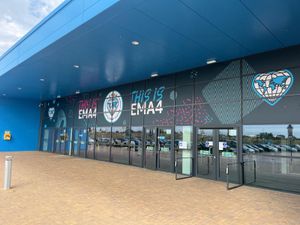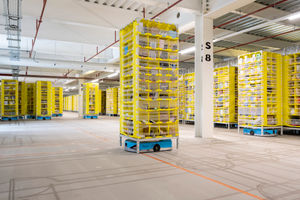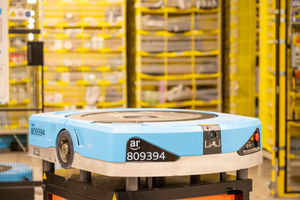Pulling into the car park feels a little like crossing into a border zone – part airport, part shipping port – a place with its own rhythms, and its own rules.
The building is roughly 650,000 sq ft over four floors.
Amazon’s fulfilment centre in Sutton Coldfield
Inside, the welcome is warm. The air smells faintly of newness and freshly scrubbed floors. Everything is factory-clean, as is the norm in modern manufacturing and logistics, and the safety-first culture is unmistakable, giant green signs greeting you straight off. Endless banks of lockers hint at the sheer number of people who work here. In the large staffroom, there’s a Super Mario-themed corner, a splash of playfulness in what is admittedly a cathedral of efficiency.
Circa 2,500 people are employed at EMA4 – interestingly, more than at a non-robotics centre.
 The entrance to EMA4, Sutton Coldfield
The entrance to EMA4, Sutton Coldfield
Before I get into how Amazon’s vast machine actually works, and the role fulfilment centres like EMA4 play in that complex yet strangely simple jigsaw, there’s a small detail or two worth pausing on.
Stepping through reception and collecting your visitor’s pass, the first thing you notice is that the HR department isn’t tucked away in some back-office suite. It’s right there, on the shop floor. Not in the corporate sense, either – it looks more like a customer service counter, the kind you’d see at a big Europcar desk in an airport.
 Inside the Amazon fulfilment centre, Sutton Coldfield
Inside the Amazon fulfilment centre, Sutton Coldfield
Amazon says this is deliberate. It makes HR more visible and more approachable. In line with the company’s “customer first” mantra, the employees here are the customers.
Similarly, a training and development hub sits just a few steps away, also in plain view.
Most employees will work four days on, three days off; shifts are 10 hours.
On the training front, everyone – yes, even the suits – goes through the same rigorous two-week induction. The idea is that anyone can roll up their sleeves and pitch in operationally as well as administratively. During Black Friday, for instance, you might see the building’s management team right alongside the packers, sealing up boxes for dispatch across the region and beyond.
On the ground floor, perhaps half the space is given over to inbound goods. Like most Amazon fulfilment centres, Sutton Coldfield handles smaller items, while other UK sites specialise in larger products, clothing and footwear, and food and drink.
Every item is checked, placed into a black storage box, and set onto one of the centre’s miles of conveyor belts. The belts carry the boxes to the next stage, where people load them onto tall storage carts. The centre has 15 miles of conveyor belts.
 Inside EMA4 Sutton Coldfield. Photo by Richard Grange / UNP (United National Photographers)
Inside EMA4 Sutton Coldfield. Photo by Richard Grange / UNP (United National Photographers)
From there, the real magic begins. These carts are whisked away by independent robots. There are no tracks, just coded markers on the floor and a remarkably smart algorithm guiding them to the right storage location. Big supermarkets use not dissimilar technology, but it’s tricky to relate just how advanced Amazon’s system is.
The Amazon robots are self-sufficient: they take themselves to a scanner – a kind of X-ray machine – which updates the system on how much space remains in their cart. When their batteries run low, they roll themselves over to a charging station and plug in until they’re ready for duty again.
 Amazon robotics at EMA4 Sutton Coldfield. Photo by Richard Grange / UNP (United National Photographers)
Amazon robotics at EMA4 Sutton Coldfield. Photo by Richard Grange / UNP (United National Photographers)
Seeing the sheer volume – thousands of products – passing through EMA4 every single day, it’s hard not to be awed. The choreography between human hands, algorithms and tireless machines is so intricate, so seamless, it’s almost beyond description. And all of that happens before you’ve even clicked “Buy Now” on Amazon.co.uk.
Once you do, an entirely new chain of processes springs into life. The system knows exactly where your item is – it was logged and stored by robots the moment it arrived. A robot heads to the location, retrieves it and sends it gliding along the conveyor belts back down to the ground floor.
Part of the reason for detailing these workflows, beyond the sheer fascination of them, is that their sophistication and efficiency are on a level most organisations could never even hope to replicate. But they can still serve as inspiration.
The Amazon fulfilment centre EMA4 at Minworth, Sutton Coldfield. Photo by Richard Grange / UNP (United National Photographers)
Amazon attracts its share of criticism for many reasons, but on the logistics front, it’s hard to argue with the results. This is efficiency and business technology at its peak, and when it comes to best-in-class operations, there are very few anywhere in the world that come close.
HOW AMAZON WORKS IN 5 STEPS
1 – Products from enterprises and other sellers arrive at Amazon’s Receive Centres – one in Coventry, one in Doncaster.
2 – An algorithm analyses historical sales data to decide how much stock to send to each of Amazon’s 32 UK fulfilment centres, including Sutton Coldfield.
3 – Receive Centres don’t store products. Instead, stock is sent to fulfilment centres, where it’s stowed, by a combination of advanced robotics and human workers, until ordered.
4 – When an order is placed, robots locate the item in storage. A human packs it, then the SLAM computer system checks it, applies an address label and decides which gate it goes to for transport to a sortation centre. This is very airport-esque.
5 – From the sortation centre, where it is given a more ultra-local final destination, it moves to a delivery station, from where Amazon’s delivery partners collect it and take it to the customer’s door.
HOW IT WORKS: SHIPPING DIFFERENT ITEMS FROM DIFFERENT SELLERS
If your Amazon order involves two separate items from two different sellers, and you’ve asked for them to arrive together (to keep boxes and delivery slots to a minimum), a clever synchronisation system kicks in. This uses lights and signals to make sure both sets of products meet at the right point in the process, a level of co-ordination that’s almost too intricate to put into words.
For single-item orders, the product moves straight to packing. Here, the process is led by people, but with precise technological support: machines cut the exact length of tape needed for each box, calculate the right amount of paper padding and display the instructions to the packer, speeding the job up while avoiding waste.
Next, the parcel is weighed, checked and given its address label. This is an automated process known as SLAM: Scan, Label, Apply, Manifest. At the end of SLAM, the system decides which gate the package should head for, ready to be loaded onto a HGV bound for a sortation centre. There, it is sorted again before travelling to a local delivery station, where an Amazon partner collects it and brings it to your door.
This sequence plays out thousands upon thousands of times every hour across the UK. If anything falters – if the delicate balance between inbound and outbound shifts – an engineering team, based in the heart of the building monitoring screens, responds instantly. Most operations staff are trained across multiple roles, ready to switch tasks at a moment’s notice to keep the flow moving. And while it pauses briefly each day for routine maintenance, this system remains the very definition of keeping things moving.